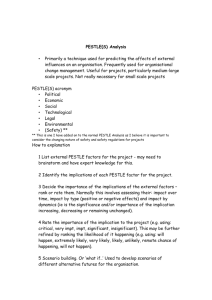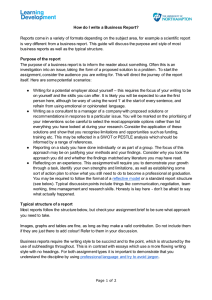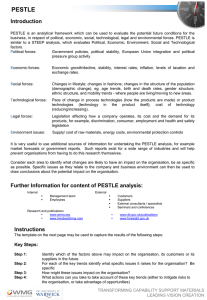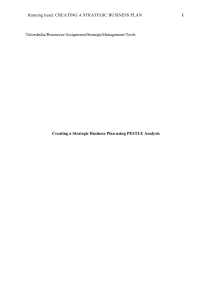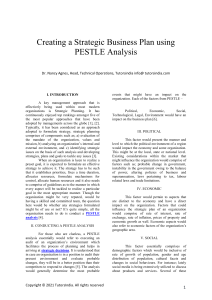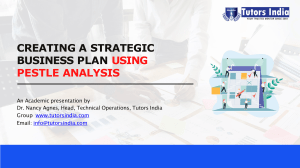PESTLE Analysis: A Critical Examination of the Model
advertisement
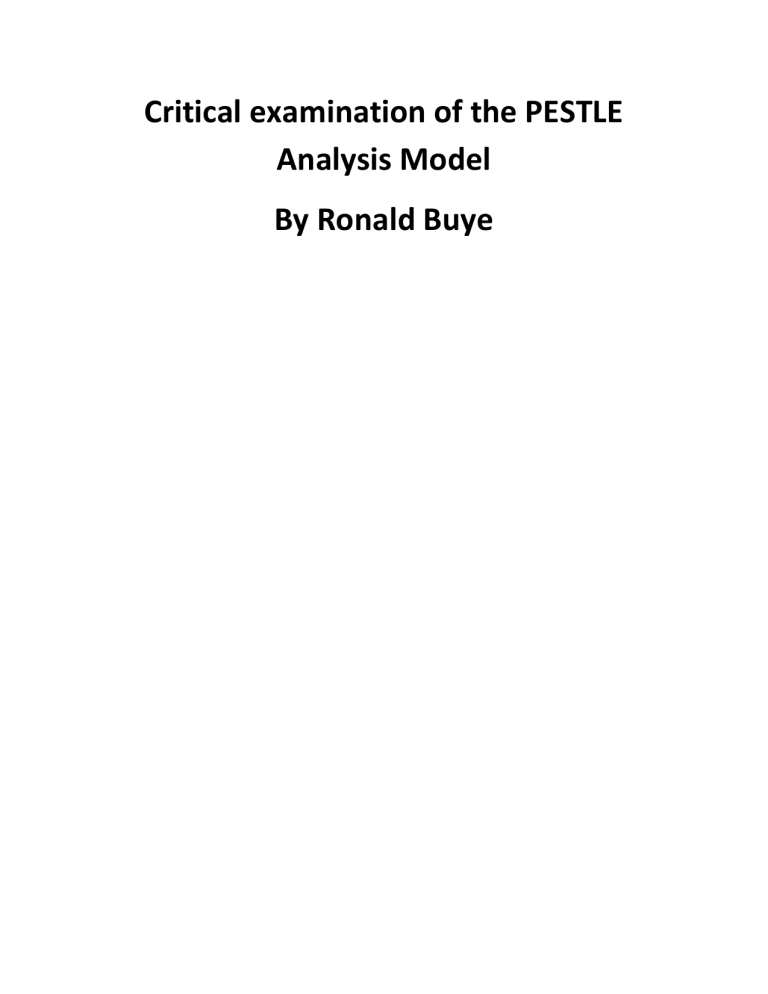
Critical examination of the PESTLE Analysis Model By Ronald Buye Introduction Organizations are composed of group of people working together for a common purpose to achieve desired goals (North, 1990: 5). Organizations are open systems with subsystems and therefore paradigm shift is necessary which focuses on interrelationships rather than cause- effects (Senge, 1990). Organizational development efforts are designed to improve the performance of organizations for businesses profit is largely used to measure performance, while for non-profit organizations, performance is measured in terms of relevance, effectiveness and efficiency. On the whole it’s therefore important to examine how the external environment affects the organization’s performance. What happens outside the organization’s precincts without a doubt influences organizational behavior. Consequently, organizational learning should constantly focus on the milieu to enable an organizationto have the ability to develop effective strategies to improve performance. The article critically examines one of the models used in organizational analysis abbreviated as PESTLE for political, economic, social, technological, legal and environmental (natural) dimension of the external environment. Each of the dimensions is presented to provide justification for the model. The macro environment analyzed using the PESTLE is congruently important as the micro environment. Organizational environment Comprises all factors and forces outside the organization that affect and can be affected by the organization. The internal setting "consists of those relevant elements and factors within the boundaries of the organization that influence organizational include organizational members, physical infrastructure, performance they organizational leadership, culture, systems and structure. External environment The external environment consists of forces and factors outside the boundaries of the organization that influence how the organization operates. The external environment can bedirect (micro) or indirect (macro). The external environment can provide both facilitating and inhibiting influences on organizational performance. Direct environment can affect its operations. It consists of clientele, suppliers, and competitors or entities that do similar work. The most important aspect of micro-environment is the clientele. Competitors are also important in the micro-environment and they include organizations with similar or related products. To remain competitive an organization should have competitive and comparative advantage over its rivals. Strengths and weaknesses analysis focuses on all aspects of internal operations, for example, people, finance, services. Macro Environment:The macro Environment includes all the factors and forces that are part of the larger society and also affect the immediate -environment. These factors are not directly under the control of the organizational but can have serious consequences on organizational performances. The factors can Cultural, Technological, Legal and Environmental. be categorized Political, Economic, Socio- Organizational analysis This is the collection, analysis and use of data focusing on forcesfrom outside the organization more often than not to improve organizational effectiveness. It’s the process of examining the operations and performance of an organization. Organization analysis is a diagnostic process that helps to better understand the performance of an organization. It can be undertaken after an initial capacity assessment to obtain deeper knowledge about the causes of organizational weaknesses and to identify emerging opportunities. The analysis is often carried outto take action to respond to negative forces. It’s helpful to be acquainted withforces that have cropped up in the organization such that appropriatestrategies are developed to address the challenges.This is an analytic process that enables organizations toassess organizational performance, by identifying strength, weakness, threats and opportunities. There are different organizational analysis tools that can be used which include:McKinsey 7S Framework, Porter's Five Forces framework, PESTLE(political, economic, Technological, legal and Social, natural environment), SWOT (strength, weakness, opportunities, threats), POCC (potential, opportunities, challenges, constraints) and SOAR analysis (strength, opportunities, aspirations and results). The focus is on PESTLE analysis which is one of the tools for conducting environmental scans on the organizations’ environment they areuseful organizational development tools for determining organizational growth or decline, organizational current state, capacity and strategic direction. PESTLE Analysis The PESTLE Analysis is one of the tools that is used to identify and analyze the key drivers of change in the organizational environment. The PESTLE Analysisis an acronym for political, economic, Social, Technological, legal and natural environment.PESTLE analysis is an organizational audit of the firm’s operations in order to determine the different factors and forces in the external environment that affect the success of an organization.. The term originated from Aguilar(1967) who presented ETPS (Economic, Technical, Political, and Social) in his book Scanning the Business Environment. . Methods of data collection include in discussions, interviews, and surveys can be used to assess the internal environment. The tool allows the assessing of the current environment and potential changes. It’s based on the premise that organizations that continuously scan their environment have competitive advantage because it helps in gathering, analyzing, and using the information to improve organizational performance. More so it’s used in predicting and evaluating the future state of affairs. It’s generally seen as part of SWOT analysis process because it examines opportunities and threats in the organization’s external environment. It is a part of the external assessment, appraisal, review and evaluation. as well as the interests of political. Economic, social, legaleconomic related stakeholders who can also be identified from the analysis and included in the results. It is very useful when an organization is commencing or different product. PESTLE Analysis can introducing a assist an organization in be acquainted with opportunities offered by existing conditions in the organizational environment. It can also be used for identifying current or possible future challenges, allowing for effective planning of how to best manage these challenges. The results of this analysis can facilitate changes or improvements in areas identified. Importance of using PESTLE analysis PESTLE analysis is a useful tool for understanding the organizational environment to identify opportunities and deal with threats It enables the organization understand the organizational environment It enables the organization use data in the strategic direction and formulate goals to help realize the mission and vision of the organization. Analysis enables the organization to identify critical factors and forces, formulate action plans, and develop goals to improve performance. It generates information for the organization to enable them plan and appraise operations for improved performance. their The tool allows the assessing of the current environment and potential changes. It helps in gathering, analyzing, and using the information to improve organizational performance. Political by the environment:PESTLE analysis is used to examine howorganizations are affected political environment. For instance the analysis can generate results on the political situations on whether there is political stability which is favorable to organizations. On the other hand unfavorable political climate including war situation and uncertainty of governments can negatively affect the organization. Identifying opportunities and dealing with threats in the political environment can greatly benefit the organization. Economic environment: The analysis using PESTLE generates data on economic situation in terms of taxes, tariffs, interest rates, economic growth, recession, inflation rate, exchange rate, minimum wage, wage rates, unemployment, cost of living, working hours, credit availability, financing availability, level of economic growth. economic situation and how it might By providing results on the impact on the organization helps it to respond appropriately. For exampleeconomic recession can negatively affect the performance and continued existence of organizations. More so, interest rates affect a firm's cost of capital and therefore to what extent an organization develops and expands. This implies that organizations, should use PESTLE to analyze the economic situation in its environment, where they operate in order to understand if the current economic environment presents opportunities or may pose threats. Social dimension: The social environment includes the values, beliefs, attitudes, opinions, and lifestyles of stakeholders. Social beliefs, values and lifestyles influence clients. The analysis of demographic factors includes the study of the human population regarding size, geographic distribution, age, education levels and income distribution. By generating demographic data it labour force. helpsorganizations todelineateits probable market and also relevant Technological dimension:by generating information on technological advances it enables organizations be prepared to applicably change and operate using the most relevant technologies. New technologies identified would improve productivity and probably reduce cost of production depending on technological advancement. However, thechanges identified in the technological environment may present opportunities or threats to the organization. For instance the cost of acquiring new technologies may significantly increase the costs of the organization, which, in turn, might affect the organizational cost of production. Many organizations use technology such as internet and telecommunication technologiesto improve efficiencyand effectiveness because they easily interact with clients and suppliers. PESTLE analysis enablesorganizations to update their own technology as it can become obsolete. Legal dimension: The legal environment includes the laws and regulations of a country. PESTLE analysis generates data on government rules and regulations that will influence the way in which an organization will produce and sell its products. Such laws can negatively or positively affect organizational operations. Organizations must analyze and identify those factors (legal environment). The Ethical dimensionwhich can be included separately also relates with the social and legal dimension. Ethical factors involve duties, values, ethos or morality, integrity, and behaviouro a particular society. This are not legal but can inform the rules of a particular society. What is ethical and non-ethical determines how the organization. A particular practice might not be ethical and therefore not acceptable in a particular community. Therefore operates what is ethical and unethical should also be analyzed . Natural Environment dimension:It also includes the nature and physical environment which consists raw materials, and other natural resources such as the land and physical space on which organization operates. PESTLE analysis examines the natural environment to generate information on pollution , raw materials and government regulations on protection of natural resources. Pollution generated by the organization or others can negatively affect its operation and reputation especially if its operations damage the environment. Hence its important to generate data using PESTLE on Environmental protection policies, pollution, waste management among others. The PESTLE model is limited by uncertainties in the external environment because external factors change and therefore need regular review which is costly. It needs an adequate time and experts to conduct the analysis . A lot of information generated by the analysis makes it difficult to understand by organizational staff internal and policy makers . More so PESTLE analysis is not feasible and is inadequate because it only focuses on the macro environment, ignoring the micro environment and the internal factors. Other Organizational Analysis Models Strategic Triangle Model This model determines the efficiency and effectiveness of an organization. It’s a conceptual framework which uses three key elements: the corporation, customers and competitors forming ‘strategic trianglewhat (Ohmae,1982) and how they analyzed and integrated to improve performance. Corporation Improving its strength Informed decisions Customer Customers interests Customer needs Expected customers Customer location Competition Corporate image SWOT analysis: is an acronym for “strengths, weaknesses, opportunities, and threats.” Strengths and weaknesses are considered internal factors, and opportunities and threats are considered external factors. Using a SWOT analysis helps an organization identify where they’re doing well and in what areas they can improve. SWOT analysis SWOT or situation analysis is used when without to look at both the internal and external environment. SWOT stands for Strength, Weakness, Opportunity and Threat. The internal factors considered are the strengths and weaknesses where the opportunities and threats are external factors that are all used and considered to help improve the overall decision making process in dynamic strategic situations the business is facing. The strengths are positive characteristics in the internal business environment which can be capitalized on to increase the overall organizations performance. The weakness are factors of the internal environment which may restrict and interfere with the positive organizational performance. The internal environment factors will include finance, production, research, development and marketing. The opportunities include factors of the external environment that act like stepping stones for the organization in order to achieve their current strategic goals. The threats include the factors that have an effect and may interrupt the organization from achieving the goals. Often threats will come out of the external environment SOAR analysis: is an alternative to SWOT and it’s based on appreciative inquiry to analyze the strengths, opportunities, aspirations, results (SOAR). It focuseson the current reality anddesired state or vision to develop strategic goals. However it ignores weakness and threats because it uses appreciate inquiry approach which focuses on the positive aspects of the organization. POCC Analysis: The analysis of the Potentials and Opportunities, Constraints and Challenges (POCC) or (Strength, Weaknesses, Opportunities and Threats (SWOT) Potentials, Opportunities, Challenges, and Constraints (POCC) Analysis of Potentials, Opportunities, Constraints and Challenges (POCC) Assessing the Potentials, Opportunities, Constraints and Challenges is very crucial for planning. Key development issues, priorities and formation of programmes of action are based on existing potentials and opportunities to enhance and facilitate the chances of success. Constraints on the other hand have to be managed or addressed to ensure effective plan implementation. .Potentials, Opportunities, Challenges, And Constraints (POCC) in addressing the problems using the guidance below: Potentials refer to internal factors, advantages, and resources that can organization to enhance its chances of achieving the selected goal and objectives. enable Opportunities are the external factors (beyond the organization) that positively influence development in the organization to enhance its chances of achieving the selected goal and objectives. Challenges are the external factors or obstacles (outside the organization) that may hamper smooth development efforts. Constraints are the disadvantages emanating from internal factors that hinder the organization from achieving the selected development goal and objectives. Porter's Five Forces framework:It was developed in 1979 by Michael Porter of Harvard Business School for looking at the strength of five important factors that affect competition potential entrants, existing competitors, buyers, suppliers and alternative products/services. Using this model, you can build a strategy to keep ahead of these influences. McKinsey 7S Framework: The McKinsey 7S Framework emphasizes balancing seven key aspects of an organization. The elements are strategy, structure, and systems, shared value, staff, skill, and style. Conclusion This article focused on examining the PESTEL model used to analyze the external environment of organizations which incorporates the opportunities and the threats,. Organizations should develop strategies using the PESTLE analysis to determine the opportunities and deal with challenges in order to improve organizational performances. Threats from the macro environment should be managed by coming up with the most effective solutions. The framework has a number of limitations which includes uncertainty, cost and time constraints. Therefore organizational development efforts by change makers should use this model together with other models. REFERENCE Aguilar, F. J. (1967) Scanning the Business Environment, New York:Macmillan Company, 1967 Christodoulou, A., Argyris.C. & Schon, D. A. 1996. “Organizational learning II“, Reading, MA: Addison Wesley. Cullinane, K. from (2019). Identifying the Implementation of the Main a Port Opportunities Energy Management and Challenges System: A SWOT/PESTLE Analysis.Sustainability11(21):1-15 FAO (2013). Organization analysis and development http://www.fao.org/fileadmin/user_upload/capacity_building/LM4_v2_WEB_Light.pdf Gillespie, A. (2007). PESTEL analysis of the macro-environment. Foundations of Economics, Oxford University Press, USA. John Kew & John Stredwick (2015). Business environment. Managing in a strategic context. Charted Institute of personal development London Jeffs, C. (2008).Strategic Management. SAGE Publications Ltd., Kolios, A., Read, G. (2013). “A Political, Economic, Social, Technology, Legal and Environmental (PESTLE) Approach for Risk Identification of the TidalIndustry in the United Kingdom.Energies6(10):5023-5045 Makos, J. (2011). What is PESTLE Analysis? A Tool for Business Analysis.Weberience LLC. Retrieved from http://PESTLEanalysis.com/what-is-PESTLE-analysis/ McCann, H. (2009). PESTLE needle therapy. Journal of Chinese Medicine, (91), 20-25. North, D. 1990. Institutions, institutional change and economic performance, Cambridge, Cambridge University Press. Ohmae, K (1982).The strategic triangle: A new perspective on business unit strategy. European management journal Porter, M. E. (1979). How competitive forces shape strategy. Harvard Business Review, 57(2), 137-145. Porter, M. E. (1991). Towards a dynamic theory of strategy. Strategic Management Journal, 12, 95-117. Roper, K. (2012, November). BIM Implementation: PESTEL Drivers & Barriers (Cross-national Analysis). In World Workplace 2012. IFMA. Senge, P. M., (1990), The Fifth Discipline: The Art and Practice of the Learning Organization, Doubleday, New York, NY Stavros, J. & Cole, M. (2013). SOARing towards positive transformation and change. Development Policy Review, 1(1), 10-34. Retrieved from: https://www.researchgate.net/publication/259975881_SOARing_towards_positive_transf ormation_and_change Stavros, J., Cole, M. & Hitchcock, J. (2014, Aug.). Appreciative inquiry research review & notes: A research review of SOAR. AI Practitioner, 16(3). Retrieved from: https://www.researchgate.net/publication/284380692_Appreciative_Inquiry_Research_R eview_Notes_A_Research_Review_of_SOAR Vasileva, E. (2018). “Application of thePEST Analysis for Strategic Planning of Regional Development.”49th International Scientific Conference Quantitative and Qualitative Analysisin Economics, Economic Faculty in Nis, 223-229. Yuksel, I. (2012). Developing a multi-criteria decision making model for PESTEL analysis. International Journal of Business and Management, 7(24), 52
